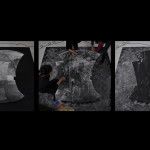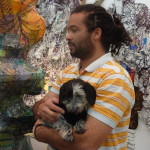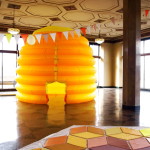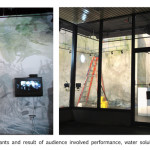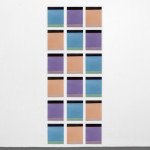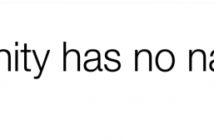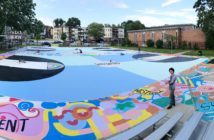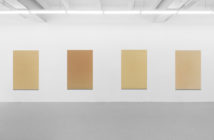sübSamsøn is an artist-in-residence program developed by Samsøn owner and director Camilo Alvarez. An artist is invited to occupy a small studio in the basement of the Gallery's 450 Harrison Avenue space in Boston for a duration of 6 months. I was curious to learn more about the model, and about the experience of both gallerist and artist as they work alongside each other. This is part one of two conversations with Alvarez and Carlos Jiménez Cahua, who ends his residency this month.
Stephanie Cardon What sparked your idea to create an artist-in-residence program at Samsøn?
Camilo Alvarez As most ideas, it comes from a variety of channels and inspirations.
1. I used to work at Skowhegan, a great residency.
2. I felt there was a need for the Boston gallery viewer to meet a maker.
3. Annina Nosei used to have Basquiat make works in her basement and then sell them in the gallery.
SC There's an unusual power dynamic in hosting someone's creative practice within the space and context of an art gallery, and yet it is a nurturing gesture towards this city's artists.
CA Well, as a gallery I still host a creative practice in the space through the gallery program, so this ‘residency’ is just an extension of that. All I do as a gallerist/dealer is a nurturing gesture towards the city and its artists, no?
SC I'm not sure gallerists are always thought of that way, but in Boston, where the scene is smaller, that's an important and alternative approach to the artist-gallerist and gallerist-community relationship. Are there other projects you partake in and ways you seek to nurture this community?
CA In working with unique objects, and personalities, and characters, constantly attempting to expose the new, I think just delving into that territory is nurturing. Samsøn hosts performances, book signings, etc. I also participate in extracurricular artistic activities which are important to keep the nearby in view: I recently juried an exhibition for the South Shore Art Center down in Cohasset, and another one opens on my birthday, April 1st, for the Wentworth Institute of Technology. Currently, I’m a thesis advisor for two graduate students at the School of the Museum of Fine Arts where I also sit on the Medici Group’s committee. I get invited to do studio visits for many of the area’s universities. One under-regarded position Samsøn stands in is the access to potential acquirers of art and their much needed patronage for the aforementioned activity.
SC What kinds of expectations, if any, do you have of the artist while they have a studio at sub-Samsøn? You chose to turn over the space to an individual for 6 months at a time—how did you settle on that duration?
CA The resident artist is expected to work. Be open during First Fridays for viewers. Pay Samsøn $357 a month. I wanted a balance with a male and a female artist per year in residence. I also thought 6 months was a good chunk of time to get something going.
SC What have you gained from this experience personally? That the artist pays rent brings me back to the potentially conflicted economics of this model but, that aside, what surprises have you had?
CA It has been rewarding to work with artists that have had low if any interaction with the opportunities available to Samsøn. I don’t necessarily consider the $357 paid to Samsøn ‘rent’. It’s a ‘fee’ for its services and access. A contribution to culture is impossible to quantify or valorize, so who’s really being rewarded? I think it’s most rewarding for the viewer.
SC What's your daily relationship with them the artist? Do you offer critiques? Do you facilitate studio visits with other curators, or writers, or collectors?
CA We get pretty close, my desk is in the adjoining room. I arrange studio visits for the resident artist with all the artists I work with when they’re in town. Also with the artists I exhibit. Everyone that walks into the gallery eventually gets to peek in the studio, if not stay for a more in-depth studio visit. I try to get the resident artist press, sales and future exhibition opportunities. At the end of the residency we do a ‘project’ together which has taken many forms.
SC How have you decided which artists to host? Is it primarily an interest in/curiosity about their work, or is it more through suggestions? Would you share any stories from past residencies and some of these final projects you did with the artists?
CA I invite them. It is primarily an interest in the artist and his or her work. I’ve been told I am a good judge of character…sometimes. I seek hard working, appreciative, easy-going people with passion. Sometimes too much of it can be detrimental, there has to be a balance. Mike [Szegedi] and Zsuzsi [Zsuzsanna Varga Szegedi] are husband and wife and they were the initiators to a certain degree. Each are so different and experienced in their own ways. They have two kids who played with sübSamsøn themselves. Mike was the 1st sübSamsøn resident, so he was the only one with whom I wanted to do a final project actually in the gallery ... in Samsøn. For Zsuzsanna, we convinced the Fourth Wall Project to give her a solo exhibition. John C. Gonzalez had a new ‘conversation’ every month: one was with a doctoral fellow, one with a local curator, all kinds… For John’s final ‘project’ we are renting a storefront sometime in the Spring of 2013. Maria [Molteni] made the initial plans for her inflatable beehive which will start to be shared. I personally kickstarted some cash on that and will assist in finding new venues for her to inflate it. Carlos has had some serious collector interest, so with him I think applying to art fairs and hopefully doing one will serve as the project. I’m curious to see how Susan Metrican works it.
SC Is this a model you'd encourage other galleries to adopt? And if so/not, why?
CAI don’t know if other galleries would be able to adopt such a model considering the experience I have had. I do know that the gallery model is somewhat outmoded and needs to shift a bit…
SC Interesting. How is it outmoded, in your opinion?
CA There is no doubt that the divide between the haves and have-nots is increasing. That has had an effect on the commercial art market. So alternative art spaces and small nonprofits find it harder to survive while museum institutions become larger and focus more on the aesthetics of their patrons. This is also due to the waning of public funding. These patrons or collectors also have increased in largesse, in turn increasing the power of the auction system and creating the art advisor or consultant. Neither professes social responsibility. Will we start tearing up the caves of Lascaux like Banksy’s walls for auction? Prevailing cultural norms and a narrow market-oriented economy encourage a skewed emphasis.
Every object thus thought falls under the rubrics of ‘the market’. I now speak of ‘the market’ in a more social sense, where people exchange ideas based on objects, which is more important than the commercial definition. What is left when the economics are highlighted more than the actual object or thought behind it? (Perhaps that’s part of the loss of criticality?) It’s most importantly a loss to and for the senses which will make us dull as shit. We need to play…it is not all business.

Carlos Jiménez Cahua
Untitled #63, 2012
Six 14x11-inch chromogenic color prints, 14 x 121 inches (installed)
- Zsuzsanna Varga Szegedi Stills from Wipeout, 2010 Time-lapse stop-motion video Running time 2:45 min
- Camilo Alvarez
- Maria Molteni and Colette Aliman The Beehive, 2013
- Zsuzsanna Szegedi, Erase with Me Fourth Wall Project
- Carlos Jiménez Cahua Installation View: Ich will doch nur, daß ihr mich liebt; für t, 2012 Eighteen 10×8-inch chromogenic color prints 65 x 26 inches (installed)





